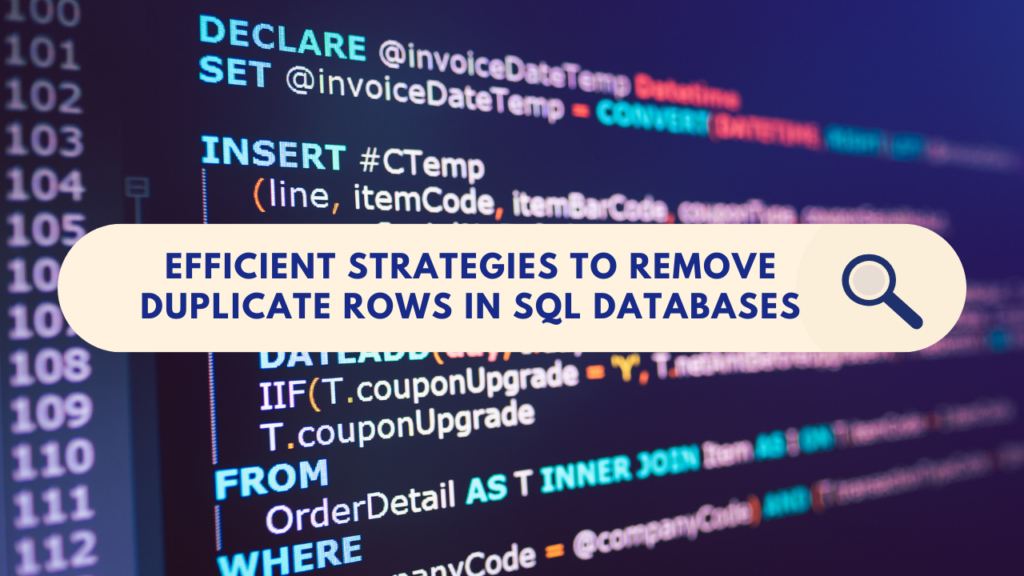Mastering SQL: Techniques to Remove Duplicate Rows

Duplicate records cluttering your SQL database can impede performance and accuracy. To streamline data management, let’s explore various SQL methods for identifying and eliminating duplicate rows efficiently.
1. Deleting Duplicate Rows using Group By and Having Clause
Employ SQL’s robust functionalities like the GROUP BY and HAVING clauses to identify and eliminate duplicates. By aggregating identical records and filtering using specific conditions, SQL can efficiently pinpoint and remove duplicate entries.
2. Fetching and Identifying Duplicate Rows in SQL
Precise identification of duplicate entries is crucial before deletion. Utilize SQL’s SELECT statements in conjunction with GROUP BY to accurately identify and retrieve duplicate records within your dataset.
3. Deleting Duplicate Rows Using Common Table Expressions (CTE)
Common Table Expressions (CTEs) offer a structured approach for handling complex queries. Utilize CTEs along with functions like ROW_NUMBER() to systematically remove duplicate rows while maintaining database integrity.
4. Procedure for Removing Duplicate Rows
Streamline duplicate removal by creating a reusable SQL procedure. Encapsulating SQL logic within a procedure ensures an efficient and standardized approach to routinely cleanse data.
5. Using CTE Rank Function to Delete Duplicate Rows
Leverage the RANK() function within a CTE to identify and eliminate duplicate records based on specific criteria. This method provides a granular approach to tackling duplicates in your database.
6. Use SSIS Package to Delete Duplicate Rows
SQL Server Integration Services (SSIS) packages provide a visual interface for constructing data transformation workflows. Utilize components such as Conditional Split or Lookup within SSIS to efficiently identify and remove duplicate entries.
7. Use Sort Operator in an SSIS Package for Removing Duplicating Rows
The Sort operator within SSIS aids in organizing data for easy identification of duplicates. By arranging data, subsequent steps for removing duplicate rows become more streamlined.
Conclusion
Efficient management of data integrity is not just a best practice but a cornerstone for optimal performance in SQL databases. The array of techniques available for removing duplicate rows empowers database administrators and developers to maintain a clean and streamlined database environment.
From utilizing SQL’s inherent capabilities like GROUP BY, HAVING clauses, and Common Table Expressions (CTEs) to harnessing the power of SQL Server Integration Services (SSIS) packages, each method offers a unique approach suited to varying database complexities.
The careful identification and systematic elimination of duplicate records significantly contribute to improved data accuracy, streamlined processes, and enhanced performance. Choosing the right method depends on factors such as dataset size, complexity, and the desired level of granularity in removing duplicates.
Implementing these strategies ensures data remains consistent, accurate, and reliable. Furthermore, it simplifies ongoing data maintenance tasks, allowing for streamlined operations and efficient data-driven decision-making.
Remember, the cleanliness and accuracy of your database directly impact the efficiency and reliability of applications and processes reliant upon it. Regularly employing these techniques not only ensures data cleanliness but also lays the foundation for a robust database structure, paving the way for more effective data analysis, reporting, and system performance.
In conclusion, the consistent application of these methods ensures a well-maintained database, setting the stage for data-driven success and unlocking the full potential of your SQL environment. Regularly optimizing your database by eliminating duplicate records is an integral part of maintaining a healthy and efficient data ecosystem.

Leave a Reply